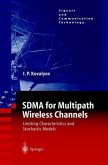This book gives a detail description of the handover issues in DVB-H networks, in converged DVB-H/UMTS networks and in hybrid DVB-H/DMB-T networks. Besides, the DVB-H signalling information including ESG is discussed. The current status and the future research directions of DVB-H and DVB-H handover are presented so that the readers can also get an overview of the research methods being used.
Although this book is research focused, it also gives a detail introduction to the basic concepts such as handover, time slicing, ESG, etc.. This book is written in a way that even people without prior knowledge of DVB-H can easily understand. At the end of each chapter there are some questions and there are solutions to those questions at the end of the book.
This book can be used by researchers, engineers, academics, regulatory bodies and business managers as a reference book, or by university students as a text book or a reference book.
"European industry has already developed successful standards in the past, and I am very con?dent that on the basis of DVB-H, Mobile TV services can developtheeconomiesofscaletheyneedfortake-upacrossEuropeandaround the world," With these words of EU's Telecom Commissioner Viviane Reding, DVB-H is destined to be a dominating mobile TV technology in Europe and even in the world. I was ?rst getting in touch with the DVB technology when I was doing my PhD research in Brunel University in UK in 2002. At that time DVB-T was already a mature and widely used digital broadcast technology and anyone could easily buy a DVB-T receiver in the market to try the digital broadcast signals that have been already broadcasted in UK since 1998. Then the DVB technology world changed dramatically. As a more ?exible and robust terr- trial broadcast system targeting handsets, DVB-H was developed based on DVB-T. In 2003 the DVB-H community were continuously working to ?n- ize the standard. Finally in November 2004 DVB-H was adopted as an ETSI standard EN 302 304. I was lucky to see all these changes when I was doing my PhD research in DVB technology. And I was very proud to be involved in the di?erent DVB-H research projects since the beginning of the DVB-H standard development stage. I was also lucky enough that I am one of the ?rst persons who ?nished PhD degree by focusing on DVB-H research.
Although this book is research focused, it also gives a detail introduction to the basic concepts such as handover, time slicing, ESG, etc.. This book is written in a way that even people without prior knowledge of DVB-H can easily understand. At the end of each chapter there are some questions and there are solutions to those questions at the end of the book.
This book can be used by researchers, engineers, academics, regulatory bodies and business managers as a reference book, or by university students as a text book or a reference book.
"European industry has already developed successful standards in the past, and I am very con?dent that on the basis of DVB-H, Mobile TV services can developtheeconomiesofscaletheyneedfortake-upacrossEuropeandaround the world," With these words of EU's Telecom Commissioner Viviane Reding, DVB-H is destined to be a dominating mobile TV technology in Europe and even in the world. I was ?rst getting in touch with the DVB technology when I was doing my PhD research in Brunel University in UK in 2002. At that time DVB-T was already a mature and widely used digital broadcast technology and anyone could easily buy a DVB-T receiver in the market to try the digital broadcast signals that have been already broadcasted in UK since 1998. Then the DVB technology world changed dramatically. As a more ?exible and robust terr- trial broadcast system targeting handsets, DVB-H was developed based on DVB-T. In 2003 the DVB-H community were continuously working to ?n- ize the standard. Finally in November 2004 DVB-H was adopted as an ETSI standard EN 302 304. I was lucky to see all these changes when I was doing my PhD research in DVB technology. And I was very proud to be involved in the di?erent DVB-H research projects since the beginning of the DVB-H standard development stage. I was also lucky enough that I am one of the ?rst persons who ?nished PhD degree by focusing on DVB-H research.








